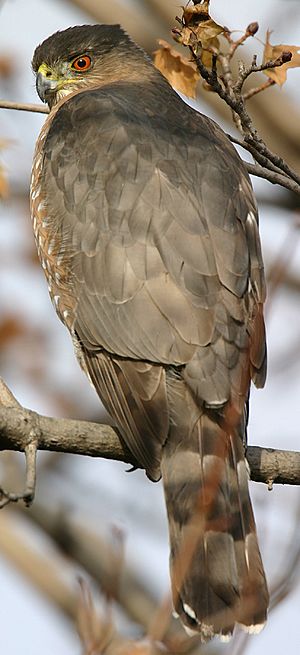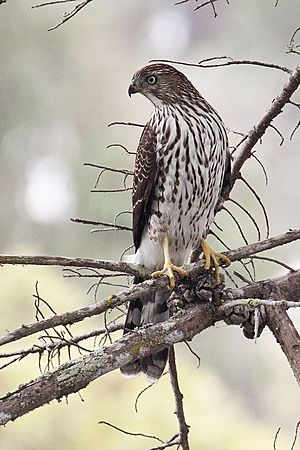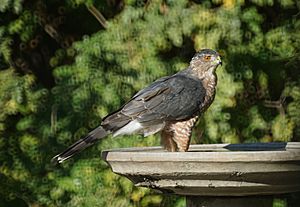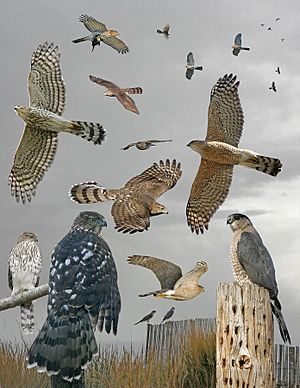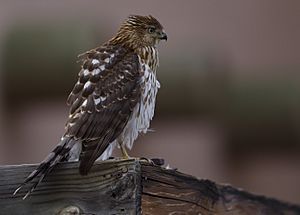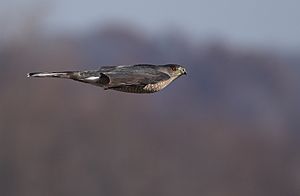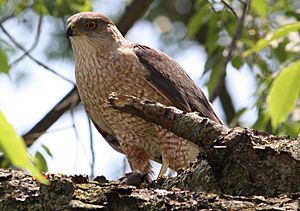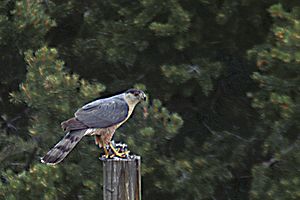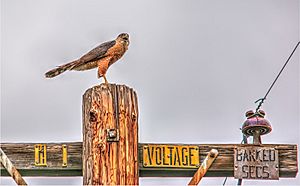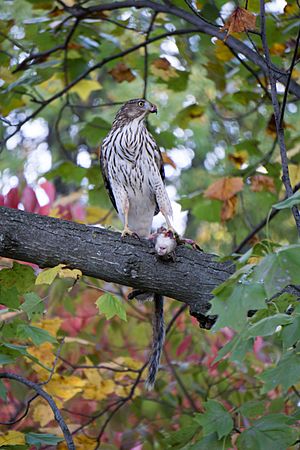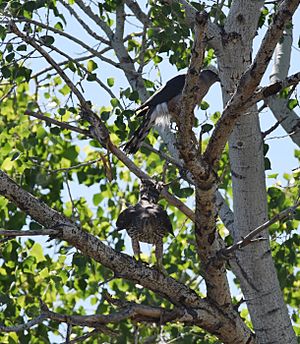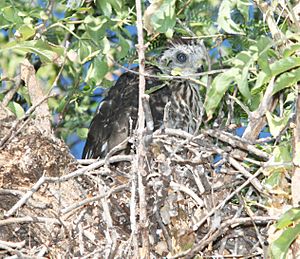Cooper's hawk facts for kids
Quick facts for kids Cooper's hawk |
|
|---|---|
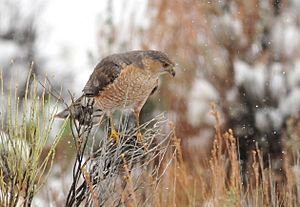 |
|
| Conservation status | |
| Scientific classification | |
| Genus: |
Accipiter
|
| Species: |
cooperii
|
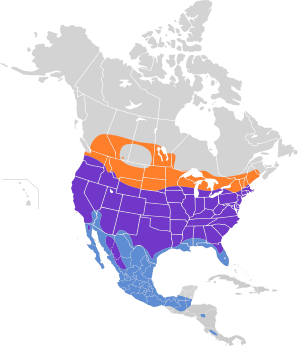 |
|
The Cooper's hawk (Accipiter cooperii) is a medium-sized hawk that lives in North America. You can find them from southern Canada all the way down to Mexico. These birds are known for being very quick and agile, especially in wooded areas. Like many birds of prey, the female Cooper's hawk is larger than the male. It can sometimes be hard to tell them apart from the smaller but similar Sharp-shinned hawk.
This hawk was named in 1828 by Charles Lucien Bonaparte to honor his friend, William Cooper, who was also a naturalist. People sometimes call them "chicken hawks" or "swift hawks" because they are so good at hunting. Cooper's hawks mostly hunt small to medium-sized birds. They also eat small mammals and sometimes reptiles.
Cooper's hawks like to build their nests in tall trees where there's lots of leafy cover. They usually raise two to four young birds, called fledglings, depending on how good the conditions are. In the past, their numbers went down because of pesticides and other chemical pollution. But now, their population is stable and doing well.
Contents
About Cooper's Hawks
What's in a Name?
The Cooper's hawk got its official name in 1828. It was named by a French naturalist, Charles Lucien Bonaparte. He chose the name to honor William Cooper, an American naturalist. William Cooper helped start a science group in New York.
Other old names for the Cooper's hawk include "big blue darter" and "hen hawk." These names often describe how fast and skillful they are at hunting. The Cooper's hawk belongs to a group of birds called Accipiter hawks. These are sometimes called "true hawks" and are known for being very agile hunters in forests.
How They Look
Cooper's hawks are medium-sized birds, but they are quite large for an Accipiter hawk. They have wings that are not too long, and a long tail that often looks rounded or wedge-shaped. Their legs and toes are long and strong. Their eyes are set forward, which helps them see prey clearly. They also have a strong, hooked beak for tearing meat.
Adult Cooper's hawks can be blue-gray or brownish-gray on their backs. They have a darker cap on their head and reddish-brown stripes on their chest and belly. Their tail is blue-gray with three dark bands and a white tip. Young Cooper's hawks are dark brown on top. Their chests have brown streaks. Their eyes are yellow when they are young, but they turn orange or red as they get older.
In flight, Cooper's hawks look fairly small, even though they are medium-sized. Their wings are short compared to their long tails. They fly with quick, stiff wing beats and short glides. They often soar with their wings held slightly raised.
How Big Are They?
Female Cooper's hawks are much larger than males. Females can be about 20% longer and weigh about 40% more! This difference in size between males and females is called sexual dimorphism.
A full-grown male Cooper's hawk is usually about 35 to 46 centimeters (14 to 18 inches) long. Females are larger, from 42 to 50 centimeters (17 to 20 inches) long. Their wingspan can be from 62 to 99 centimeters (24 to 39 inches), with an average of about 84 centimeters (33 inches).
Males typically weigh between 215 to 390 grams (7.6 to 13.8 ounces). Females are heavier, weighing from 305.8 to 701 grams (10.8 to 24.7 ounces). The heaviest hawks are usually found in the eastern United States.
What Do They Sound Like?
Cooper's hawks have many different calls. Their most common call is a harsh, cackling sound, like "keh-keh-keh." Males usually have a higher-pitched voice than females. They also make softer calls when they are with their mates or young.
When young hawks are born, they make "cheep" or "chirrp" sounds. As they grow, they develop a loud hunger call, like "eeeeeeee-oo." Outside of the breeding season, Cooper's hawks are usually quiet.
Who Do They Get Confused With?
It can be tricky to tell Cooper's hawks apart from other hawks in North America. The two most similar species are the smaller sharp-shinned hawk and the larger northern goshawk.
Cooper's hawks are usually about the size of a crow. Male Cooper's hawks are like a small crow, and females are like a large crow. Sharp-shinned hawks are smaller, more like a large Steller's jay.
Here are some ways to tell them apart:
- Size: Cooper's hawks are bigger than sharp-shinned hawks.
- Head: Cooper's hawks have a larger, more noticeable head that sticks out when they fly. Sharp-shinned hawks have a smaller, rounder head.
- Tail: Cooper's hawks have a longer, more rounded tail with a wider white tip. Sharp-shinned hawks have a shorter, more squared tail with a thinner white tip.
- Flight: Cooper's hawks have a stronger flight with slower wing beats. Sharp-shinned hawks have a more bouncy flight with faster wing beats.
Northern goshawks are much larger than Cooper's hawks. Adult goshawks look very different with broad white stripes above their eyes and a darker back. Young goshawks can look similar to young Cooper's hawks, but goshawks have heavier streaks on their underside and zigzag patterns on their tails.
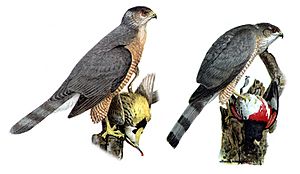
Where They Live
Their Home Range
Cooper's hawks breed from southern Canada down to northern Mexico. They live in most of the contiguous United States. In winter, they move south from the colder northern areas. You can find them across most of Mexico during winter, and sometimes even further south into Central America.
What Kind of Places Do They Like?
Cooper's hawks prefer to live in different kinds of forests, especially deciduous and mixed forests. They also like wooded mountain areas. They can even live in some conifer forests.
They are very good at adapting to different environments. They can live in small woodlots, along rivers, and even near farmlands. They often like areas with forest edges and clearings, because these are good places to hunt.
Cooper's hawks usually live at elevations from sea level up to 2,500 meters (8,200 feet). They often choose tall, dense conifer trees for nesting, as these offer good shelter. However, they also use tall deciduous trees like American beech and oaks.
Interestingly, Cooper's hawks have adapted well to living near people. They are now quite common in urban and suburban areas, even nesting in cities. Cities offer them plenty of prey, like pigeons and doves and other common birds.
How They Behave
Cooper's hawks are active birds, especially in the morning. They often rest in conifer trees, tucking their heads in to sleep. During the day, they spend time cleaning their feathers. They prefer to drink water from quiet, hidden spots. Sometimes, especially in dry areas, they might drink from man-made water sources.
These hawks are very strong flyers, which helps them accelerate quickly when hunting and carry heavy prey. They can even chase prey on the ground, half-running and half-flying. Young Cooper's hawks are sometimes a bit clumsy and might crash into bushes while hunting. Adults are more careful.
Cooper's hawks are usually top predators during the day. However, they can be attacked by other larger predators. The great horned owl is their main enemy. These owls are much bigger and will hunt young and adult Cooper's hawks. They might even take over a Cooper's hawk nest.
Traveling Far: Migration
Many Cooper's hawks migrate, meaning they travel to different places for the winter. They usually move out of the colder northern parts of their range, like southern Canada and the northern United States. Hawks that live further south might also move around, but usually not as far.
They typically migrate south in the autumn, from late August to mid-October. They fly back north in the spring, from late February to May. Young hawks usually migrate earlier than older ones. Females also tend to migrate sooner and stay longer in their winter homes than males.
Cooper's hawks often follow mountain ridges and coastlines during migration. They prefer to fly when the day is warmer and they can use rising air currents, called thermals, to help them glide. They usually migrate alone, but sometimes you might see small groups of two to five.
What They Eat
Cooper's hawks are bold and aggressive hunters. They eat mostly vertebrate animals. Their favorite foods are small to medium-sized birds, but they also eat many small mammals. In dry areas, they regularly hunt lizards. Sometimes, they might even eat frogs, insects, or fish.
Birds make up about 50-85% of their diet. They are estimated to kill about two birds a day, which is around 700 birds a year! They often hunt birds that live on the ground or in bushes.
Hunting Style
When a Cooper's hawk sees a bird, it doesn't fly straight at it. Instead, it circles around, using trees and bushes for cover. It might perch for a moment before launching a surprise attack. They are very agile and can twist and turn through trees to catch their prey.
They often hunt near forest edges, open woodlands, and fence lines. In cities, they hunt in neighborhoods, parks, and even golf courses, especially where there are large trees. They are known to attack birds that visit bird feeders.
Sometimes, Cooper's hawks hunt together. One hawk might chase prey while another waits on the other side of a tree. They are very powerful for their size. They kill most prey by squeezing it with their strong talons. Sometimes, they even hold living prey underwater to drown it.
Favorite Meals
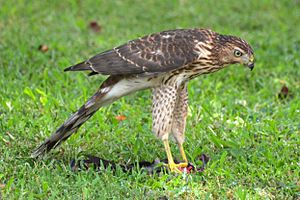
The most common bird they eat is the American robin. Robins are found everywhere, so they are an easy target. Another very common prey bird is the common starling, which is a non-native bird in North America.
They also hunt many other types of birds, especially medium-sized ones. Blue jays and Steller's jays are popular prey. Cooper's hawks also hunt crows, but crows can be dangerous because they are large and can mob the hawk in groups.
Pigeons and doves are very important prey, especially for Cooper's hawks living in cities. They often eat mourning doves and rock doves. Woodpeckers, like the northern flicker, are also a common meal.
Cooper's hawks are known for hunting quails. They can even chase quails into thick bushes. They also occasionally hunt larger game birds like ruffed grouse and common pheasants. Sometimes, they even go after very large birds like adult pheasants, which can weigh over 1 kilogram (2.2 pounds)!
Mammal Meals
While birds are their main food, mammals can be important too. Chipmunks are often hunted, especially the eastern chipmunk. They also eat ground squirrels.
Tree squirrels are also a common food source. Smaller squirrels like the American red squirrel are often taken. Larger ones, like adult gray squirrels and fox squirrels, can be too big for them, so they usually only catch young ones.
Occasionally, Cooper's hawks hunt rabbits and hares, especially young ones. They are known to catch cottontail rabbits. They also sometimes hunt bats, catching them in mid-air.
Other Prey
In some areas, Cooper's hawks hunt a good number of reptiles, especially lizards. They usually catch small lizards. They can also hunt snakes, from tiny ones to young, larger species like the black rat snake.
Very rarely, they might eat frogs or even insects like beetles and butterflies.
Who Hunts the Hunter?
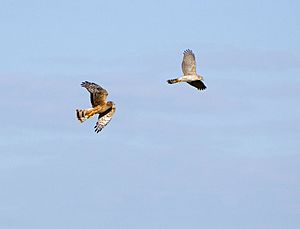
Cooper's hawks are usually at the top of the food chain during the day. But they can be hunted by other predators. The biggest threat to them is the great horned owl. These large owls often raid Cooper's hawk nests, eating the young and sometimes even the adults.
Other large birds of prey, like northern goshawks and red-tailed hawks, might also hunt Cooper's hawks. Raccoons are also a big threat to nests, eating eggs and nestlings. American crows sometimes steal eggs from their nests.
Cooper's hawks, in turn, hunt smaller birds of prey. They are known to prey on American kestrels and merlins. They also hunt smaller owls like screech-owls and northern pygmy owls.

Family Life
Finding a Mate and Nesting
Cooper's hawks are usually solitary, except when they are breeding or migrating. They typically have one mate. However, sometimes a female might mate with two males!
Breeding can start as early as February in warmer areas, but it's usually from April to July. The male arrives in the nesting woods first, then the female joins him. They often fly in circles together high in the sky as part of their courtship. The male might do a special "sky-dance" with slow, rhythmic wing flaps.
They build a large, platform-like nest, usually about 61 to 76 centimeters (24 to 30 inches) wide and 15 to 45 centimeters (6 to 18 inches) deep. They use sticks and line the nest with bark or green leaves. Nests are often built high up in a main fork of a tree, usually 8 to 15 meters (26 to 49 feet) off the ground. They prefer areas with lots of tree cover.
Cooper's hawks usually build a new nest each year, but sometimes they reuse an old one. New nests are often built close to old ones.
Eggs and Young
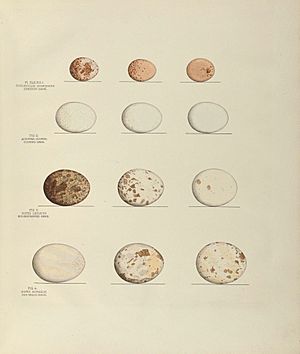
Females usually lay 3 to 5 eggs, one every other day. The eggs are pale sky blue and fade to a dirty white. Incubation, when the female sits on the eggs to keep them warm, starts after the third egg is laid. It lasts for 34 to 36 days. The female does most of the incubating, while the male brings her food.
When the chicks hatch, they are covered in white downy feathers and have blue-gray eyes. They weigh about 28 grams (1 ounce). The female stays on the nest until the young are about two weeks old. The male brings food to the nest, often removing the head and insides of the prey first. As the young grow, the male has to hunt constantly to feed them all.
The young grow very quickly. By three weeks old, they can stand up and feed themselves. They start to leave the nest, or "fledge," at about 30 days for males and 34 days for females. Even after they leave the nest, the young hawks still rely on their parents for food for a while. They are often loud and demanding when asking for food.
Young Cooper's hawks usually stay near their siblings for a short time after leaving the nest. They might even hunt together. They usually start breeding when they are two years old.
How Long Do They Live?
Cooper's hawks can live a long time. Some have been recorded living up to 20 years in the wild! However, many young hawks don't survive their first year.
One of the biggest threats to Cooper's hawks, especially in cities, is collisions with man-made objects. They can fly into wires, cars, or windows, especially when they are focused on hunting.
Status and Protection
Past Problems
In the early 20th century, Cooper's hawk numbers went down a lot. This was mainly because people hunted them. Many people saw them as a threat to game birds like quails or to smaller birds they liked. They were shot, poisoned, and trapped.
Later, in the 1960s and 1970s, their numbers dropped again. This time, it was because of harmful chemicals like DDT (a pesticide). DDT made their eggshells very thin, so the eggs would break easily. This chemical affected many birds of prey that ate other birds or fish.
Thankfully, DDT was banned in North America. After that, the Cooper's hawk population started to recover and grow rapidly in the 1980s and 1990s.
Today's Status
Today, the Cooper's hawk population is doing very well. There are estimated to be around 800,000 Cooper's hawks in the United States and Canada. Their numbers have increased a lot since the 1970s.
They are now one of the most common birds of prey in American cities. This shows how adaptable they are, even with the dangers of city life.
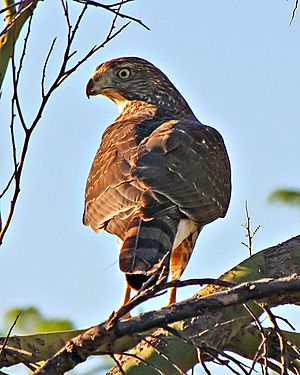
New Challenges
Even though their numbers are stable, Cooper's hawks still face some threats.
- Collisions: As mentioned, flying into wires, cars, and windows is a major cause of death, especially in urban areas.
- Pesticides: While DDT is banned, other pesticides can still harm them.
- Lead Poisoning: They can get lead poisoning from eating prey that has been shot with lead bullets.
- Habitat Loss: Like all wildlife, they need enough suitable habitat to live and breed. Logging and development can reduce their living spaces.
Scientists recommend creating "buffer zones" around their nests. These are areas where human activity is limited to protect the nesting hawks.
Sometimes, Cooper's hawks might hunt rare or endangered birds. However, studies show that their hunting usually doesn't cause a major decline in these species. They mostly hunt common birds that are abundant in their area.
Images for kids
See also
 In Spanish: Gavilán de Cooper para niños
In Spanish: Gavilán de Cooper para niños



